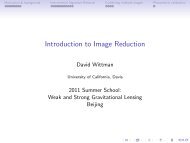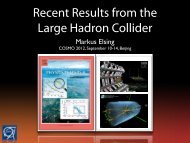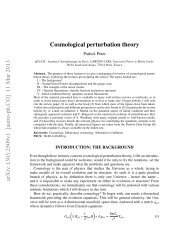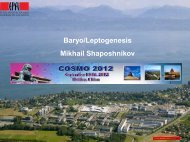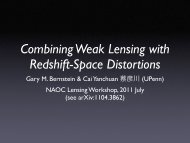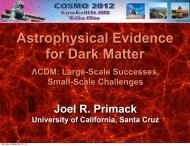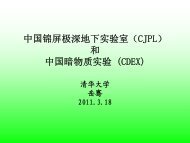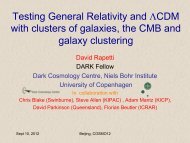Large-Scale Structure of the Universe and Cosmological ...
Large-Scale Structure of the Universe and Cosmological ...
Large-Scale Structure of the Universe and Cosmological ...
Create successful ePaper yourself
Turn your PDF publications into a flip-book with our unique Google optimized e-Paper software.
such as <strong>the</strong> abundance <strong>of</strong> massive clusters [538,385,691,522].<br />
Results on <strong>the</strong> redshift-space bispectrum in <strong>the</strong> CfA/PPS sample [31] (see<br />
Fig. 57) <strong>and</strong> <strong>the</strong> skewness <strong>of</strong> CfA/SSRS surveys [246] were used in [224] to<br />
put constraints on <strong>the</strong> non-local (scale-dependent) bias in <strong>the</strong> cooperative<br />
galaxy formation (CGF) model [96] proposed to generate enough large-scale<br />
power in <strong>the</strong> context <strong>of</strong> o<strong>the</strong>rwise-st<strong>and</strong>ard CDM. This model corresponds to<br />
a (density-dependent) threshold bias model where galaxies form in regions<br />
satisfying δ > νσ − κδ(Rs), where κ is <strong>the</strong> strength <strong>of</strong> cooperative effects<br />
<strong>and</strong> Rs describes <strong>the</strong> “scale <strong>of</strong> influence” <strong>of</strong> non-locality. Figure 57 shows <strong>the</strong><br />
predictions <strong>of</strong> CGF models for (κ, Rs) = (0.84, 10 h −1 Mpc) (dot-long-dashed),<br />
(2.29, 20 h −1 Mpc) (solid) , <strong>and</strong> (4.48, 30 h −1 Mpc) (dot-short-dashed), all <strong>of</strong><br />
which have similar large-scale power to a Γ = 0.2 CDM model. Because <strong>of</strong><br />
<strong>the</strong> scale dependence induced by <strong>the</strong> CGF models, additional linear bias is<br />
required to suppress <strong>the</strong>se features, which in turns implies non-zero non-linear<br />
bias to maintain agreement with Q3 ∼ 0.5 <strong>and</strong> also would be in disagreement<br />
with <strong>the</strong> normalization implied by <strong>the</strong> CMB [596]. In addition, this would<br />
make <strong>the</strong> agreement with <strong>the</strong> simple prediction <strong>of</strong> PT from Gaussian initial<br />
conditions purely accidental. Similar results follow from <strong>the</strong> analysis <strong>of</strong> <strong>the</strong><br />
skewness S3, see [224].<br />
As discussed in Sect. 8.3.3, <strong>the</strong> detection <strong>of</strong> <strong>the</strong> configuration dependence <strong>of</strong> <strong>the</strong><br />
bispectrum in IRAS surveys (see e.g. Fig. 58) gives a tool to constrain galaxy<br />
bias, primordial non-Gaussianity, <strong>and</strong> break degeneracies present in two-point<br />
statistics. Using a maximum likelihood method that takes into account <strong>the</strong><br />
non-Gaussianity <strong>of</strong> <strong>the</strong> cosmic distribution function <strong>and</strong> <strong>the</strong> covariance matrix<br />
<strong>of</strong> <strong>the</strong> bispectrum [566], <strong>the</strong> constraints on local bias parameters from IRAS<br />
surveys assuming Gaussian initial conditions 146 read [567,211]<br />
1<br />
b1<br />
1<br />
b1<br />
1<br />
b1<br />
=1.32 +0.36<br />
−0.58 ,<br />
=1.15 +0.39<br />
−0.39,<br />
=1.20 +0.18<br />
−0.19,<br />
b2<br />
b2 1<br />
b2<br />
b2 1<br />
b2<br />
b2 1<br />
= −0.57 +0.45<br />
−0.30 , (2Jy.) (630)<br />
= −0.50 +0.31<br />
−0.51, (1.2Jy.) (631)<br />
= −0.42 +0.19<br />
−0.19, (PSCz) (632)<br />
with <strong>the</strong> best fit model shown as a dashed line in Fig. 58 for <strong>the</strong> PSCz<br />
case. These results for <strong>the</strong> linear bias <strong>of</strong> IRAS galaxies, when coupled with<br />
measurements <strong>of</strong> <strong>the</strong> power spectrum redshift distortions, which determine<br />
β = Ω 0.6<br />
m /b1 ≃ 0.4 ± 0.12 for <strong>the</strong> PSCz survey [299,643], allows <strong>the</strong> break <strong>of</strong><br />
<strong>the</strong> degeneracy between linear bias <strong>and</strong> Ωm, giving Ωm = 0.16 ± 0.1.<br />
If bias is local in Lagrangian, ra<strong>the</strong>r than Eulerian, space <strong>the</strong> bispectrum<br />
146 In addition, <strong>the</strong>se constraints assume a fixed linear power spectrum shape given<br />
by Γ = 0.21, in agreement with power spectrum measurements. See [566,567] for sensitivity<br />
<strong>of</strong> bias parameters on <strong>the</strong> assumed power spectrum shape. The dependence<br />
<strong>of</strong> <strong>the</strong> bispectrum on <strong>the</strong> assumed Ωm is negligible, as first pointed out in [313].<br />
257



